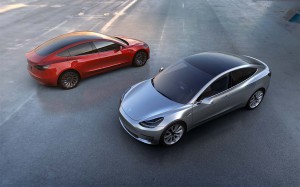Technical problems, along with the company’s own “hubris” led to a shortfall in first quarter production at Tesla Motors, primarily of the new Model X battery-electric SUV.
The Silicon Valley automaker says it delivered 14,820 vehicles during the January to March quarter, insisting it is “on track” for its full-year target. But production was heavily lopsided in favor of the older Models S battery-electric sedan, with only 2,400 of the newer Model X utility vehicles rolling out of Tesla’s plant in Fremont, California.
“The root causes of the parts shortages wereTesla’s hubris in adding far too much new technology to the Model X in version 1,” the company said in blunt terms, adding it was also impacted by “insufficient supplier capability validation, and Tesla not having broad enough internal capability to manufacture the parts in-house.”
Industry observers say the carmaker failed to include another factor for the slow ramp-up of Model X production: ongoing issues with the big vehicle’s unusual “falcon wing” doors. That reportedly led it to park hundreds of early versions, rather than shipping them to customers, until the issue could be addressed.
Though CEO Elon Musk has tried to downplay the problem with one of the battery-ute’s signature design features, Tesla sued a Swiss contractor, Hoerbiger Automotive Comfort Systems for problems with the original falcon door hinge design. The carmaker eventually had to redesign the hinges.
In its first-quarter report, Tesla claims that early problems with the Model X, including parts shortages, have been resolved. By the end of March, it said, production of the utility vehicle had risen to a rate of 750 a week, “however many of these vehicles were built too late to be delivered to their owners before end of quarter.”
The parts issue reportedly involved about six of the 8,000 unique parts that go into the Model X, though Tesla declined to say which parts were involved in the shortage.
The parts shortages and door design issues reflect the many problems Tesla has faced bringing the Model X to market, a process that ran about two years behind the company’s original schedule. During a news conference earlier this year, CEO and founder Elon Musk noted that the original plan was to largely share parts with the Model S sedan. But it became apparent during development that the Model X would require a significant number of unique components.
(Better late than never. Click Here for more on the Model X.)
While Tesla expects to flex the production mix at the Fremont plant in order to reflect ongoing customer demand, Musk said that the goal is to produce roughly equal numbers of the two current Tesla models, with sales expected to reach somewhere between 80,000 and 90,000 for all of 2016. That would be as much as an 80% increase from 2015 sales numbers.
Nonetheless, it would mean that Tesla would be using only a small fraction of the plant’s total capacity. Previously operated as part of a joint venture between General Motors and Toyota, the Fremont facility could ultimately roll out as many as 500,000 vehicles annually, Musk noted during the unveiling of the new Model 3 last week.
(For a closer look at the Tesla Model 3, Click Here.)
The goal is to reach the plant’s capacity by around the end of the decade, largely through sales of the more mainstream Model 3 sedan. But some industry analysts suggest the carmaker’s problems with the Model X suggest Tesla will face trouble going forward.
Musk suggested he was himself less than 100% certain the debut of the latest battery-car would meet its production launch target. Saying the goal was to get the Model 3 into showrooms “next year,” the South African-born executive quickly added, “I feel fairly confident they will begin next year.”
A lengthy delay could lead some potential customers to cancel orders, analyst Joe Phillippi, of AutoTrends Consulting, told TheDetroitBureau.com, especially with competitors such as General Motors bringing their own, long-range and affordable battery-cars to market in the months ahead.
Tesla, for its part, has noted that early reservations of the Model 3 are now approaching 300,000.
(Early orders growing fast, but will the Tesla Model 3 be a hit or a hype? Click Here for more.)



